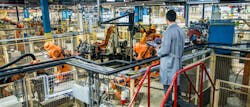No so long ago, the manufacturing industries—both process and discrete—experienced fairly predictable economic trajectories. The industries tended to rise and fall in response to commercial and consumer spending trends. But those predictable cycles in manufacturing are no longer so predictable, partly due to the influence of pervasive technologies like the internet and mobile computing on every market that manufacturing serves. And those effects impact the technologies manufacturers themselves use to respond to their customers.
To better understand the factors affecting industry today and how those factors, in turn, impact the direction of automation technologies, we connected with Justin Kolbe, the head of power and industrial automation market strategy for Henkel, a global provider of adhesives, sealants, and functional coatings, for a recent episode of the “Automation World Gets Your Questions Answered” podcast series. Henkel’s role as a supplier and user of industrial products and technologies gives the company an interesting vantage point on automation, as the materials the company provides enable thermal management, reliable electrical function, and long-term sustainability to the power and industrial automation markets.
A detailed example Kolbe provided to explain this focused on how device designers historically used an air gap to provide the correct voltage insulation. Now they use solid insulation, like a potting or some other coating, to provide that insulation. Kolbe said the benefit to this change is that it increases the power density of the device, which is required as more functions are packed into a smaller space. “With these new insulation approaches, more power devices can be placed in a tighter space while maintaining safety agency creepage and clearance distances. In some cases the insulation can also be used as a conduction path to remove heat,” he said.
From a higher-level point of view, Kolbe noted how manufacturing markets are capital expenditure-driven markets. This means that manufacturers are always concerned about the initial cost of a new device or piece of equipment. “But we are starting to see more and more awareness and sensitivity to overall operational expense as well as increasing interest around some product-as-a-service models,” he said. “This means that technology suppliers are no longer just looking at the initial cost of implementing a solution, but the total cost of ownership their customers will face. And what they ultimately want to do is reduce the total cost of ownership or be able to provide more function, more convenience, more uptime, and more throughput—all at the same cost.”
Robotics
Considering the highly visible role of robotics in industry over the past several years, Kolbe pointed out how the COVID-19 pandemic has brought even more attention to collaborative robots. “Since these robots can operate with minimal human interaction, they can act as go-betweens in production cells and be thoroughly cleaned or disinfected between human interactions. This means that robots can provide for a much safer work environment by allowing for less human density in the inner production cell or elsewhere on the plant floor.”
He also noted the role robots are playing in hazardous environments, which makes the use of protection technologies—like pottings or special coatings—so important, because they protect the robot’s electronics.
“Another place where we see robots really continuing to increase their penetration in industry is in sensitive environments like semiconductor fabs or paint spray booths,” Kolbe said. “In these kinds of production areas, designer need to make sure that the construction materials they use won't contaminate the environment. An example of this would be the use of silicone-free or highly controlled silicone materials that don't leach out over time and potentially cause production process and yield issues.”
Positional sensing is another trend in robotics Kolbe said is worthy of note in terms of influence on automation technology in general. This technology is often used in mobile robots. “These sensors are high power diodes that require accuracy and stability of placement,” he said.
Power
Since automation of any kind simply doesn't exist without power, the technologies associated with industrial power supplies are a major factor for any company looking to implement automation at any level, whether they're new to automating processes, or if they're adding to an array of automation technologies already in place.
“Electric power conversion is a key aspect across many industrial automation applications,” said Kolbe. “And one application we’re seeing increasing customer interest in is in the use of battery-powered electric applications, such as warehousing robots. This means that charging is an area where we’re seeing an increase in interest around power conversion—in factors like fast charging and wireless charging of batteries.”
Another automation area of focus around power in manufacturing is power factor correction. “Proper power factor correction allows the plant to use the power delivered to it in the most effective way, allowing the power system within the plant to work closer to capacity,” said Kolbe. “This also allows the plant to avoid usage fees from the state or utility based on poor power factor.”
Referencing the semiconductor industry, which plays a major role in automation electronics, Kolbe pointed out how this industry is moving away from the use of silicon semiconductors and toward wide band gap semiconductors, like silicon carbide, for power modules or surface-mount components because of their ability to increase the power density of a device.
“Wide bandgap semiconductors can provide much more efficient solutions, but in general they have a higher initial cost,” explained Kolbe. “But there are some applications, like inverters for alternative energy or motor inverters for 24/7 operations, where these semiconductors can offer an acceptable return on investment.”
“And by using wide bandgap semiconductors or silicon carbide, automation technology suppliers can decrease the space used by the power function,” Kolbe said. “Some of these new power electronics packages can provide electrical isolation, which allows for different cooling strategies, like double-sided cooling. And we're also seeing greater interest in baseplate-free power module designs. Historically, there has been a large copper plate placed on the back of a power module. But in the newer iterations of these designs, that copper plate is removed to reduce the weight, reduce the size, and reduce the cost of the power module.”
All these automation power trends, require “new solutions in thermal management and packaging of the overall assembly to make the best use of the capabilities they provide,” Kolbe said.
Trends to watch
Clearly higher levels of device and system connectivity around IIoT and Industry 4.0 will continue to play a big role in automation for years to come. Beyond these trends, Kolbe stressed that industrial technology end users should be paying attention to the inroads being made by artificial intelligence.
“Complex cognitive machine systems are not only changing what's possible to accomplish with automation, but they’re also changing automation design requirements due to their computationally intense processes that are going to require significant investments [from technology suppliers] in power utilization and software,” he said.
Kolbe added that any differentiation in functionality offered by a technology supplier has to occur against “the backdrop of reliability.” Any new technology “should have a long service life and the ability to run continuously without quality issues or defects that can cause downtime and reduce capacity,” he said.
Another factor to watch for in new automation technologies are specific increases in efficiency. For example, increasing voltages and decreasing current. “This is an area where efficiencies can really improve,” said Kolbe. “In older systems, where you would run a DC bus at six or 12 volts, the ability to push that voltage up to 48 or 50 volts and stay within intrinsically safe limits is a space where real improvements are going to happen.”
About the Author
David Greenfield, editor in chief
Editor in Chief

Leaders relevant to this article:

